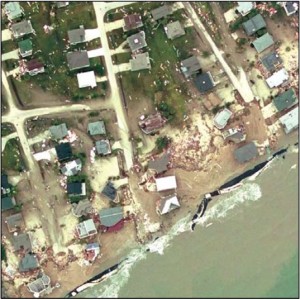Rolling Easements
In all of the Gulf States, state ownership of submerged bay-side wetlands will migrate inland as tidal wetlands migrate with rising sea level, due to the common law rules of erosion and the public trust doctrine. In effect, then, a kind of rolling easement already exists on the bay shores in all five states. Wetlands, and the legal protections they enjoy, will migrate inland where topography and lack of development permit the migration.
This de-facto rolling easement, however, has one very significant difference compared to the Texas Open Beaches Act: the common law rules are ineffective in areas were bulkheads have been constructed to hold back the sea since the shoreline does not change as a result of the bulkheading. The boundary line between public and private property has been fixed. Where development occurs landward of coastal wetlands on the bay side, none of the Gulf states would force the movement of bulkheaded structures inland of the new mean high water mark in the case of sea level rise, in effect recognizing the permanence of the bulkheaded structure.
About the Texas Open Beaches Act
Unique among most states, Texas maintains a “rolling easement” on the Gulf shores to protect public access to the state’s beaches. The concept embodied in the TOBA has been termed a “rolling easement” and it evolved from Texas common law which recognized that Gulf beaches have been used by the public since “time immemorial” and that barrier islands are constantly shifting. The TOBA allows private land owners to develop their beachfront property as long as that development does not interfere with public access. As the vegetation line gradually moves the public access easement takes effect[1]
The Texas Open Beaches Act (TOBA) was passed in 1959 to assure that the public has the “free and unrestricted right of ingress and egress to and from” public beaches, defined as the area between the line of vegetation and the mean low tide line. Because the vegetation and low tide line shift due to natural coastal processes, the demarcation lines for public beaches are not static. The public’s right of access, or easement, moves as well.
The TOBA prohibits the construction of an “obstruction, barrier, or restraint of any nature which would interfere with the free and unrestricted right of the public” to access the beach. Holding back the sea, either through bulkheading or seawalls is, therefore, not permitted along public beaches. One thing that should be noted is that the public easement created by the TOBA does not affect the title to the property to which it attaches. The TOBA, however, makes that ownership subject to an easement that allows the public free and unrestricted use of the beach.
Challenges to Texas Open Beaches Act

Aerial photograph of the west end of Galveston Island right after Hurricane Ike (courtesy NOAA). The vegetation line in this photo has shifted well inland of the first row of houses, and in some cases beyond the second row. If the new line proves to be stable for more than a year, some of these homes will have to be moved out of the public easement.
Buildings located seaward of the vegetation line must be removed if those buildings become an impediment to public access to the beach, as they do when the vegetation line shifts. A structure is an impediment to public access merely by being in the public access zone. As might be expected, property owners affected by changing vegetation lines do not take kindly to having to move their houses. Litigation occurs after every major storm when any number of houses end up seaward of the vegetation line, but the Texas courts have uniformly upheld the validity of this law since its inception in 1959 until 2012.
Historic Challenges
The majority of the challenges to the TOBA are based on the Takings Clause of the Fifth Amendment which requires the government to compensate landowners when their property is taken for public use. Government regulation can result in compensatory takings if a property owner loses all economically viable use the land.( Lucas v. S.C. Coastal Council, 505 U.S. 1003, 1019 (1992)) Texas has partially protected itself against takings claims under the TOBA. The Act requires that deeds for properties sold after October 1, 1986 contain a disclosure statement to warn buyers of the potential loss of their homes or buildings due to the movement of the vegetation lines. Such statements notify owners that they do not have a right to maintain structures seaward of the vegetation line.
Severance v. Paterson
In 2012, the Texas Supreme Court weakened the Texas Open Beaches Act. After Hurricane Rita, Texas sought to enforce TOBA on properties on Galveston Island that were now (though not previously) located seaward of the vegetation line. The owners sued the State in Federal District Court, though the TOBA rolling easements were upheld. The landowners appealed to the Fifth Circuit, which asked the Texas Supreme Court to determine if TOBA rolling easements applied to sudden changes in the shore, such as what happens with hurricane damage.
The Texas Supreme Court ruled that the TOBA rolling easement did not automatically apply (or spring forward so to speak) to eroded beaches and adjacent property after storm events. Upholding a property owners right to exclude others from one’s property, the Court ruled that the State could only take property via eminent domain with just compensation, an appropriate use of state police power, a legal easement, or other pre-existing limitation on property. The Texas Supreme Court ruled that none of these conditions were satisfied by the State argument. Through the State argued that property owners were aware of the TOBA requirements, the Court found that this knowledge did not displace an owners right of to exclude.
[1]Therefore, the previous rolling easement line of TOBA was found to remain in place after sudden storm events, but could migrate with gradual natural changes to the beach. This ruling invalidates the rolling easement concept as it applies to sudden storm events. However, the rolling easement was upheld for gradual coastal change.
H.B. 3459: 2013 Amendment to TOBA
After the Severance v. Paterson ruling, the TOBA was amended by H.B. 3459 to grant decision-making authority to the General Land Office. The General Land Office was granted the authority to suspend the determination of the line of vegetation after it is destroyed by a sudden “meteorological event”, and to determine the new location of the line of vegetation. This authority is discretionary, and whether or not it is exercised to uphold private property rights or public access rights will be determined by the Commissioner of the General Land Office.
No Protection Landward of Vegetation Line
The Texas Open Beaches Act does not explicitly prohibit bulkhead construction landward of the vegetation line. What then, impedes developers from constructing bulkheads inland of the vegetation line? In point of fact, nothing in the law prohibits such construction. Many single-family homes on or near the beach in Texas are built on pilings or stilts to achieve the elevation needed to obtain insurance (17 feet). Little or no bulkheading accompanies stilt-built structures as a matter of practice.
There are, however, several high-rise condominium structures going up on the east side of Galveston Island. This part of Galveston Island is one of the relatively few areas on the Texas coast that are undergoing accretion rather than erosion, and the investors must feel there will be enough time to recoup their investment before the vegetation line moves. Other high-rise structures found along the beach in Texas on the vegetation line or just seaward of it were likely grandfathered in place.




